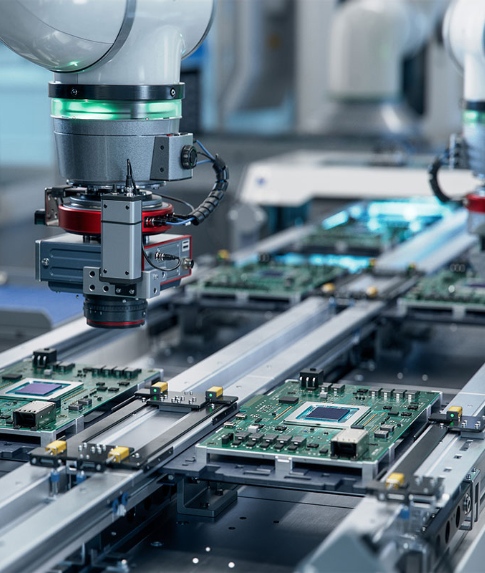


Rigid boards are made of FR-4 epoxy resin glass fiber and other materials with high strength and stable mechanical properties, and are widely used in consumer electronics, industrial control and other fields. Its internal copper foil layer is drilled and etched to form fixed circuits, which can still maintain flatness after high-temperature soldering, but lacks flexibility to adapt to complex spatial layouts.
Flexible boards are made of flexible materials such as polyimide (PI), usually less than 0.3mm thick, and can be folded or bent up to 10,000 times or more according to the needs of mechanical movement. Its copper foil circuit layer through the calendering process, with thin, light, high space utilization characteristics, but the bending radius is too small may lead to fatigue failure of the insulating layer.
Through precision design and multi-layer lamination technology, Rigid-Flex combines the advantages of rigid and flexible boards. The rigid area is responsible for carrying high-density components, while the flexible segment adapts to dynamic mechanical connections, making it suitable for smartphones, aerospace, and other scenarios that require high space and reliability. Its laminated structure needs to be specially optimized to prevent the risk of delamination caused by differences in the coefficients of thermal expansion of different materials.
II. Comparative performance analysis
|
Typology |
Mechanical strength |
Bending life |
Thermal conductivity |
Tightness |
Manufacturing cost |
|
Rigid PCB |
extremely high(can withstand high intensity mechanical impacts, suitable for structural support scenarios) |
inapplicable(Rigid materials cannot be bent) |
favorable (Copper layer has high thermal conductivity, but overall heat dissipation is design dependent) |
differ(Gaps can easily lead to moisture intrusion) |
medium(Mature technology, low raw material costs) |
|
Flexible PCB |
relatively low(Avoid sharp corners, easy to deform under long-term pressure) |
excellent((PI substrate can withstand >100,000 bends, special customisation can be higher) |
usual(Thermal conductivity is only 1/3-1/5 that of rigid boards) |
talented(Seamless design for waterproof and dustproof scenarios) |
high(requires precision coating and laminating processes) |
|
Rigid-Flex PCB |
high(Rigid zones provide support and flexural segments accommodate dynamic stresses) |
favourable(Design optimised for more than 100,000 bends) |
medium(Heat dissipation needs to be enhanced by the thickness of the copper layer and the thermal conductive medium) |
talented (Combined with the sealing feature of the flexure section, protection class IP67+ is achieved) |
high(Multi-layer lamination and process complexity increase costs) |
1. Space limitation:Flexibles or rigid flexibles are preferred for tight confined spaces.
2. Sporting need:Flexible solutions are preferred for frequent bending scenarios.
3. Reliability requirements:Military grade products must be rigid-flex composite design
4. Cost control:Large-volume residential products favour traditional rigid panels
• Wearable devices:Flexible sensor arrays connected by 0.2mm thick rigid-flex pcb
• automotive electronics:Multi-layer flexible panels in the instrument panel for flexible connection of the instrument assembly to the main control unit
• Medical sensors:Ultra-thin flexure plates embedded in body-implanted devices withstand millions of dynamic stresses
V. Outlook for future trends
With the growth of 5G high-frequency and high-speed transmission demand, both electromagnetic shielding performance of the rigid-flexible combination of boards will become the core carrier of the next generation of intelligent hardware. New PI substrate R & D breakthroughs (such as high glass transition temperature Tg value of materials) will promote the temperature resistance of flexible boards to more than 200 ℃, laying the foundation for automotive electronics upgrade.
Our hours
24H